KU MedChem Newsletter Spring 2021
Note From the Chair
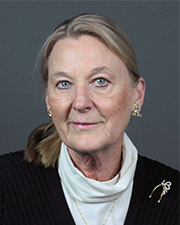 Without question, 2020 will be a year to remember at the University of Kansas. The Department of Medicinal Chemistry survived one of the most challenging years in its history. Late in the spring semester, the University sent all students home, and classes were completed online. During the summer, the University administration and the Douglas County Health officials went to work planning for summer and the fall semesters. This was an overwhelming and seemingly endless endeavor, but the fall semester came with most classes taught online.
Without question, 2020 will be a year to remember at the University of Kansas. The Department of Medicinal Chemistry survived one of the most challenging years in its history. Late in the spring semester, the University sent all students home, and classes were completed online. During the summer, the University administration and the Douglas County Health officials went to work planning for summer and the fall semesters. This was an overwhelming and seemingly endless endeavor, but the fall semester came with most classes taught online.
The School of Pharmacy held classes online as well as in person and was able to end the semester in good standing. This was an extraordinary experience for all students and faculty with learning first and later mastering the art of Zooming. At times, faculty spent hours and hours on Zoom and became proficient at juggling classes, professional meetings, seminars and departmental/school duties. Nevertheless, everyone survived with a sense of accomplishment and a very special thank you to everyone – faculty, students and staff.
Among the highlights of 2020, Bob Hanzlik reached retirement at just the right time. He is enjoying his time with Lois and catching up on yard duties. Please read his comments later in the newsletter.
I returned as department chair and have spent the year buried in academic and administrative work as we adjusted to the move to the Structural Biology Building on the West Campus. I have spent many hours on Zoom with my commitment to department administration, teaching, NIH National Advisory Council obligations and many seminars.
The department is now housed in just two buildings, the Integrated Science Building, now commonly known as the Gray Little Hall and the Shankel Structural Biology Center. During the pandemic, all dedicated research buildings were closed to the public. Only those performing research were allowed in their respective buildings.
Many changes took place during the year with extremely restricted travel denying faculty of their usual in-person research presentations, study sections and professional meetings. All seminars and lectures in the School of Pharmacy and Medicinal Chemistry Department were accomplished via Zoom. The staff were instructed to work from home when possible, but that did not stop the department from accomplishing many of the goals set forth in previous years. In this newsletter, you will find more information on what the faculty have been up to and the many accomplishments of our graduate students and alumni.
Thank you,
Barbara N. Timmermann, Ph.D.
University Distinguished Professor and Department Chair
Departmental Awards
Irsay-Dahle Award for Excellence in Medicinal Chemistry
Kelsey Knewtson, a graduate student in Blake Peterson’s laboratory was selected as this year’s Irsay-Dahle Award winner. The Irsay-Dahle Award was established to provide an annual award to an outstanding senior graduate student in the Department of Medicinal Chemistry at the University of Kansas. Recipient qualifications include quantity and quality of research accomplished, original research proposal, quality of seminars, GPA and citizenship in departmental affairs.
For more see: Irsay-Dahle Award for Excellence in Medicinal Chemistry - 2020 Recipient
Lester and Betty Mitscher Prize for Excellence in Medicinal Chemistry
Jacob Immel, a graduate student in Steven Bloom’s laboratory, received the 2020 Mitscher Prize for Excellence in Medicinal Chemistry. Dr. and Mrs. Lester Mitscher established the Mitscher Prize, awarded annually to a student who excelled in the various stipulations required for becoming a candidate for the doctorate in Medicinal Chemistry. Recipients for the prize are determined by a faculty committee selected by the chair of the Department of Medicinal Chemistry.
For more see: Mitscher Prize for Excellence in Medicinal Chemistry - 2020 Recipient
Dr. Gregory L. and Francis L. Lauver Fellowship in Medicinal Chemistry
Alonso Rodriguez in Steve Bloom’s laboratory and Annu Anna Thomas in Shyam Sathyamoorthi’s laboratory received the 2020 Dr. Gregory L. and Frances L. Lauver Fellowship in Medicinal Chemistry Award.
Dr. Lauver earned a B.A. in chemistry from the University of Kansas in 1969. After earning his M.D. from Northwestern University Medical School in Chicago, he completed an internal medicine residency at the Mayo Clinic and a pulmonary fellowship at the University of Arizona. Lauver practiced pulmonary and critical care medicine in the Phoenix area for many years.
In 2014, Lauver and his wife, Frances Lamont Lauver, established the Dr. L. and Frances L. Lauver Medicinal Chemistry Fellowship in support of graduate student research in medicinal chemistry. Lauver credits much of his success to his undergraduate education at KU. “My KU Professors, especially the chemistry and bioscience faculty, helped launch my career in medicine. The medicinal chemistry faculty nurtured my interest in respiratory pharmacology,” Lauver said.
For more see: Dr. Gregory L. and Frances L. Lauver Medicinal Chemistry Fellowship - 2020 Recipients
Bob and Lois Hanzlik Fund
This fund was established by Bob and Lois Hanzlik to support the graduate program and graduate students in the Department of Medicinal Chemistry at the University of Kansas School of Pharmacy. Bob wrote "I joined the KU School of Pharmacy in 1971 to teach and conduct research. I loved every minute of it, right up until I retired in May 2020. Through the Bob and Lois Hanzlik Fund for Medicinal Chemistry, Lois and I are helping to support the Medicinal Chemistry Department into the future and saying thank you for 49 wonderful years."
Give to the Bob and Lois Hanzlik Fund
Alumni News - Dan Flynn (Ph.D. 1982
We have some good news for one of our alumni! Dan Flynn, founder of Deciphera Pharmaceuticals, has seen his dream realized. Their first drug, QINLOCK, was recently approved by the FDA.
Dan is a native of Russell, Kansas and as a kid, delivered Bob Dole’s newspaper. He graduated from the KU School of Pharmacy in 1978 and received the MDCM award as the graduating senior who excelled in medicinal chemistry coursework. He became Les Mitscher’s first graduate student when Les arrived as our new chair in 1978. Dan completed his Ph.D. in 1982, after earnin the Irsay-Dahle Award in 1981. Dan’s thesis was titled “Synthetic studies directed toward the construction of anthracyclinones: Part I. Synthesis of 11-deoxyanthracycline antibiotics from aloe-emodin; Part II. Investigation of 4-lithio-2,2-dimethyl-1,3-dioxole as a synthon for the production of the dihydroxyacetone functionality.”
Dan did a postdoc with Paul Grieco at Indiana University and then entered the pharmaceutical industry, initially at Parke-Davis. He moved on to several other Big Pharma and biotech firms during which time he recognized the utility of the switch pocket drug design strategy—you can read more about this on the Deciphera website at deciphera.com.
He left the industry in 2002 and decided to return to Lawrence to found his company. At the time, Lawrence & KU were not heavily into biotech and had no programs to foster entrepreneurial activities, but Dan landed here and set out to gather investors. Over the years his company grew, with a significant input from KU MDCM students, currently including Yu Mi Ahn & L. N. Vogeti (Georg postdocs), Andrew Harned & Salim Javed (Hanson students), Hanumiah Telikipali (Mitscher postdoc) and Tim Caldwell (Grunewald student). The company went public in 2017 with an IPO price of $17/share. As of this writing, DCPH is trading at ca. $60/share with a market cap of ~$3.2 billion.
In Memoriam
We are saddened to announce the passing of three colleagues:
Robert Carlson - Professor of Organic Chemistry
Robert Carlson Obituary
Ed Payne - Medicinal Chemistry Storeroom
Ed Payne Obituary
KU Mad Dogs: In Memorium - Ed Payne
Mark Richter - Professor in Molecular Biology
Mark Richter Obituary
Faculty News
Steven Bloom Lab
In a year of uncertainty, the Bloom Group has continued to persevere. The group published its first manuscript in ACS catalysis, which earned me a Thieme Journal Award and a trip to Washington D.C. Their publication spurred on two additional manuscripts and laid the foundation for an innovative technology that “will revolutionize peptide drug discovery” - Mike Wiley (President, Wiley Drug Discovery Consulting LLC and former Eli Lilly Scientific Platform Leader). The group will unveil its ‘invention’ in the coming months, so stay tuned.
With support from the Chemical Biology of Infectious Disease at KU, the group will apply its new technology to develop cutting-edge treatments for HIV. We also plan to implement its peptide synthesis platform to uncover new medicines for obesity, various forms of cancer and liver disease.
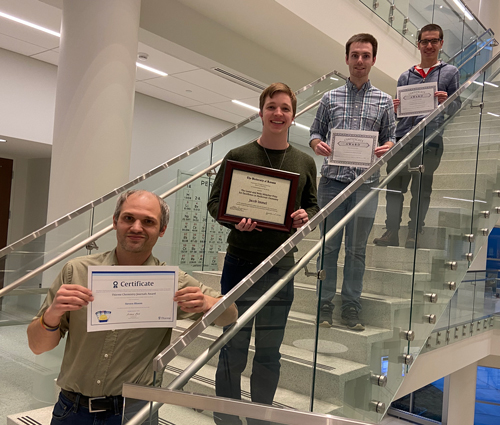
Students in the our group have also enjoyed success this year. Third-year student Jacob Immel was awarded the Lester and Betty Mitscher Prize for Excellence in Medicinal Chemistry and the opportunity to present his work at the annual Mossberg Symposium. Second-year group member Samuel Gary was named a Chemical Biology of Infectious Disease NIH Trainee, and second year Alonso Rodriguez-Ugalde was awarded the Gregory and Francis Lauver Fellowship in Medicinal Chemistry. These accomplishments are made possible by the firm dedication, strong work ethic and creativity of Bloom Group members.
To cap off the year, I became a consultant for AbbVie Inc. and Erisyon. I hope that the group’s unique approach to peptide medicinal chemistry will benefit these companies in their search for medicines that break new ground in emerging disease areas including coronaviruses.
Zarko Boskovic Lab
Running a research lab during the pandemic was not on my bingo card for 2020. The beginning of the year seemed promising: we had two papers accepted for publication, I was admitted to two Gordon Research Conferences slated for the summer, we were getting ready for the ACS Spring Meeting, for the MIKIW meeting in Madison, Wisconsin and for Bob Hanzlik Retirement Symposium.
The group operations were starting to run smoothly. I identified a great candidate to fill in a postdoctoral position in the group starting in March, and I was matched to host an undergraduate REU student over the summer. But then on March 23rd, we suspended all research operations, and e-mails of canceled conferences started coming. Events were postponed or scrapped entirely. The REU program was suspended, and the postdoc managed to sign the papers just before the hiring freeze was implemented. So our six-week exodus from the lab began. Zoom calls replaced group meetings and problem set sessions, Slack channels were opened for discussions, and computational modeling replaced lab work to stay engaged with chemistry — silicon had to do, when carbon was out of reach (they are group four congeners, after all).
The uncertainty during the initial phases of the pandemic slowly gave way to acceptance of living with the virus, and by mid-May, we were slowly resuming our research activities with masks, disinfectants, social distancing and one-way stairwells. With buildings "dedensified" and ghostly, we filled out log sheets of our lab presence, which eventually turned into digital app that checks daily on our health status. Postdoc Sri Kolluru eagerly started his experiments, and we welcomed another graduate student, Amar Kumar, around that time. Amar is a computational biologist, but he is also a wet biologist, and he skillfully assists with organometallic preparations. Lab undergraduate cohort grew quickly too. Zach Pearson continued as the lab's informatics specialist; Bryce Gaskins, a McNair Scholar, is helping Sri and Manvendra on synthesis projects; Vishva Shah, ROTC freshman, and as of recently also a McNair Scholar, works with Amar in wet biology lab. She is joined by Cybelle Arreye Smith, a Pharm.D. student who wanted to complement her pharmacy degree with some research experience. Wish granted!
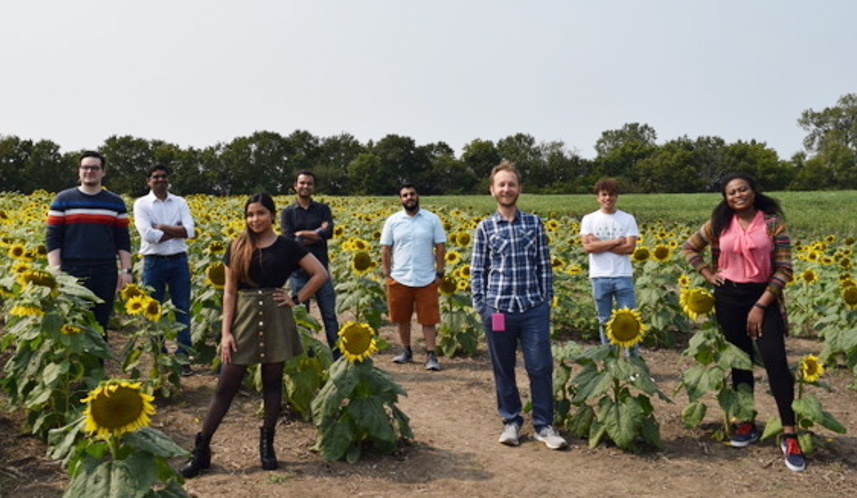
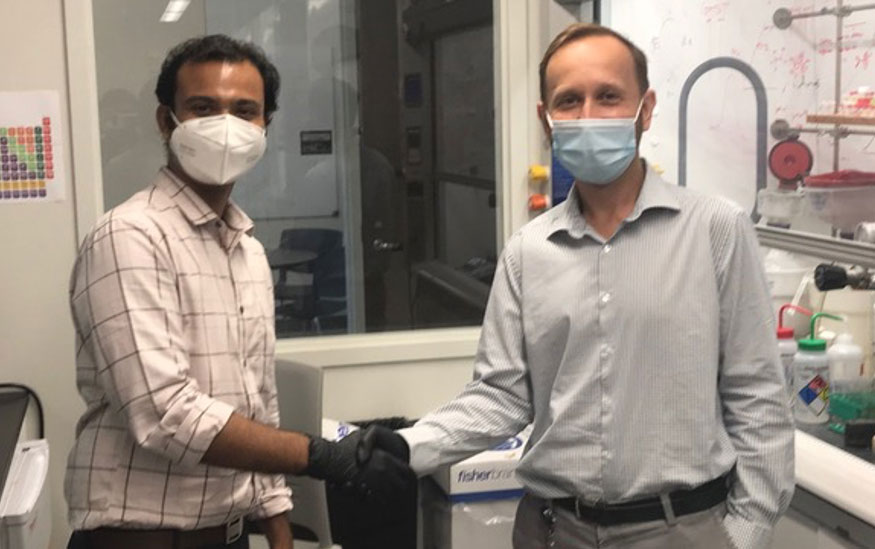
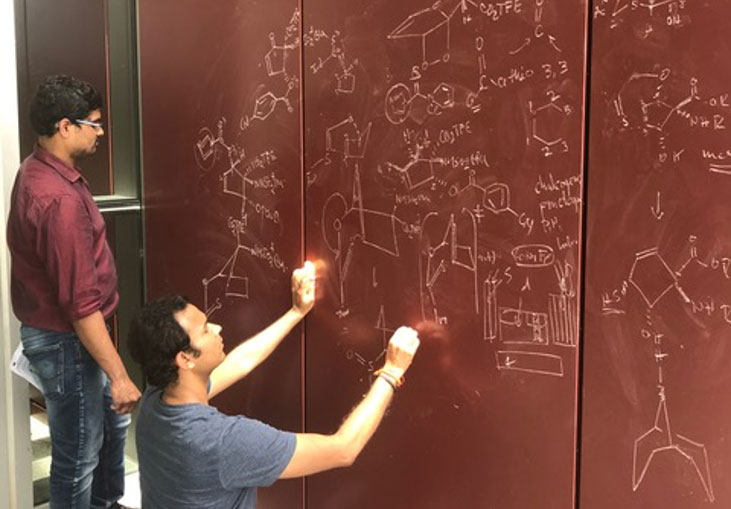
Images Above: All of us are pictured in the field of sunflowers where we ventured one day for a group outing. Manvendra Singh passed his oral examination (pictured as he's being congratulated by his mentor, both under masks). The third picture is of a Saturday noon tutorial session. We repurposed Gray-Little Hall's building sheathing material as a makeshift chalkboard — an indispensable tool for teaching chemistry. In January, Koki Takemoto will join the lab as the third graduate student and the first one from Japan.
The year behind us was challenging, but it solidified our determination to do good science and to create a learning environment to feel proud of. Thank you for following our endeavors.
Mark Farrell Lab
Over the past year, we have primarily focused our efforts on the development of molecules that enhance the killing of diseased cells by immune cells. To do this, we look to alter cellular glycosylation, which increases interactions between immune cells and target cells. The main body of our work has focused on the development of mannosidase inhibitors which disrupt N-glycosylation and drastically alter cell surface glycosylation.
Recently, we have focused our efforts on the preparation of inhibitors derived from the natural product kifunensine. We have made significant strides in the development of these kifunensine-based analogues and now have inhibitors that are >75 fold more potent than the parental natural product. We are applying these molecules in a number of different research areas in my lab and with collaborations. One collaboration of interest to the ongoing pandemic is with Professor Neelamegham (University of Buffalo) with whom we are investigating the activity of these molecules as SARS-CoV-2 entry inhibitors.
Shyam Sathyamoorthi Lab
I’ve had a fantastic two years in the Department of Medicinal Chemistry, and I am grateful for everyone’s support! Graduate student Annu Anna Thomas was awarded a 2020 Lauver fellowship for her excellent performance in her first-year coursework. We also welcomed a new postdoctoral scholar, Dr. Ranjeet A. Dhokale, from the University of Nebraska. Postdoctoral scholars Anand H. Shinde and Someshwar Nagamalla have continued their stay at the University of Kansas for another year. We were also fortunate to publish our work on tethered olefin functionalization reactions in Organic Letters, Medicinal Chemistry Research, and Chemical Science. I wish everyone a pleasant 2021!
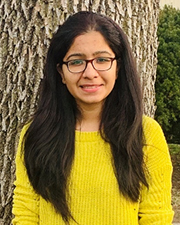
Annu Anna Thomas
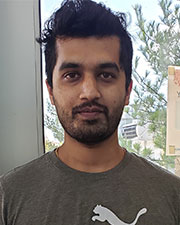
Ranjeet A. Dhokale
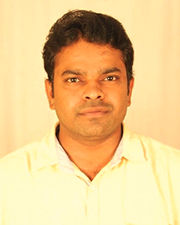
Anand H. Shinde
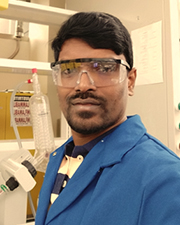
Someshwar Nagamalla
Jingxin Wang Lab
Many years later, we will still remember the year 2020, when all the academic meetings became virtual. Thirty thousand is the length of the coronavirus genome in the unit of nucleotides. It seems negligible to human’s 3.1 billion nucleotide genome, yet it completely changed, and is still changing, our lives.
During past year, we began to steer our research focus into the field of antivirals. This also aligns with our long-term research interest in regulating RNA-related biological processes using small molecules. Coronavirus is an RNA virus and can hijack different types of machinery in human cells to replicate itself, such as RNA and protein biosynthesis. A small molecule that can disrupt the viral RNA genome structure, therefore, has the potential to stop viral replication. Before any rational drug design, we need to know our “enemy” better. We used a reactive chemical, namely dimethyl sulfate (DMS), and validated the RNA structure of the viral 5’- and 3’- untranslated region (UTR).
The principle of this chemical probing is simple: DMS is more reactive to the unstable, single-stranded RNA and is less reactive to the double-stranded (or base-paired) RNA. Junxing Zhao, a postdoc in our lab, led the effort, and he took merely five months from designing the experiments to publication. In this study, we validated that a well-known functional RNA structure, namely pseudoknot, in the 3’-UTR cannot stably form in SARS-CoV-2. Funded by the KU Center for Molecular Analysis of Disease Pathways (CMADP) and the KU General Research Funds (GRF), the work was published in December in the journal Viruses (PMID: 33371200). Through preparing this paper, we also formed an active collaboration with a renowned virologist, Professor Jianming Qiu at KUMC. We have initiated different projects with Dr. Qiu targeting the stable viral RNA structures and are optimistic that we can accomplish a proof-of-concept study in the coming 2021.
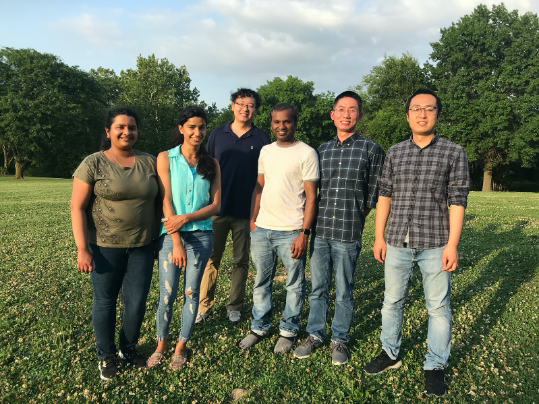
It is lucky in 2020 that we retained the talent in the lab. Two new postdocs joined our lab in the second half of the year, Manikandan Selvaraju (chemist) from KU and Srinivas Silpi Thota (microbiologist) from the University of Missouri. Under the pandemic, we have rearranged the instruments in the labs to maintain the best social distancing for our group members. We now have three fully equipped labs in the building of Structural Biology Center, for chemical synthesis, microbiology/biochemistry, and molecular/cell biology, respectively. Each room can simultaneously accommodate two researchers under the KU COVID-19 guidelines. Thanks to the department leadership, in mid-2020, we updated the analytical instruments in the lab, including taking over a departmental UPLC-MS and a semi-preparative HPLC (kindly shared by the Farrell group). This greatly enhanced the feasibility of our synthesis. With this last piece of the hardware updated, our chemical biology lab is now fully functional. We are looking forward to a fruitful 2021!
Mike Wolfe Lab
Despite the pandemic, the Wolfe Lab had a very successful 2020 on many fronts. Postdoc Sanjay Bhattarai was promoted to associate researcher in the wake of publishing a JACS communication on the discovery of transmembrane substrate mimetics for the γ-secretase complex. These peptidomimetics were designed as structural probes for cryoelectron microscopy, to capture the protease complex in its transition state of carrying out intramembrane proteolysis (see the figure). Sanjay has since developed second-generation structural probes, designed to trap the enzyme in different stages of substrate recognition and processing (manuscript in preparation), and promising images are emerging from our structural biologist collaborators. Postdoc Sujan Devkota advanced a project aimed at determining the effects of Alzheimer-causing mutations in the amyloid precursor protein on the complex proteolytic processing of this substrate by γ-secretase. Sujan made the surprising discovery that all 14 mutations he studied led to inefficient carboxypeptidase trimming by γ-secretase, with the elevation of long forms of the amyloid β-peptide. These long forms have been little studied, and Sujan’s findings, just accepted in the Journal of Biological Chemistry, suggest they may trigger the molecular events leading to Alzheimer’s disease. For his outstanding work, Sujan is also being promoted to associate researcher.
A collaboration with KU colleague Yinglong Miao in the Department of Molecular Biosciences led to the development of an all-atom molecular dynamics model of the γ-secretase complex carrying out substrate processing, a study published in the high-impact journal ACS Central Science. This collaborative work, along with advances by Sanjay and Sujan, led to a new five-year, $2.9M NIH R01 grant titled “Structure and Function of γ-Secretase in Familial Alzheimer’s Disease.”
Graduate student Shweta Malvankar passed several major milestones this year, successfully passing her proposal presentation, comprehensive oral exam and departmental research seminar. All this happened while Shweta was expecting her first child, a girl born in October, only weeks after her seminar! I did no professional travel this year, due to the pandemic, but did give an invited seminar, via Zoom, to the Department of Medicinal Chemistry at Virginia Commonwealth University.
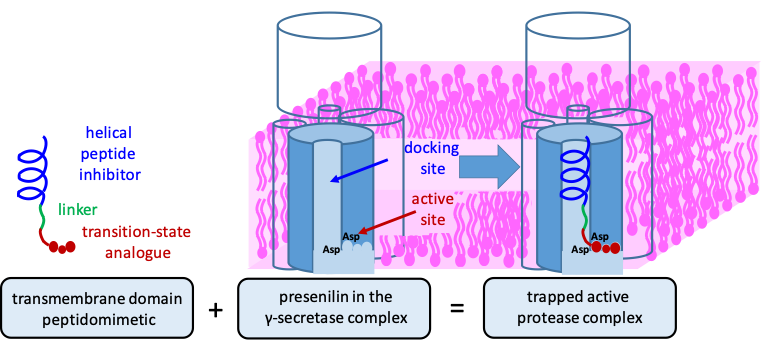
Figure: Schematic diagram illustrating the design of transmembrane substrate mimetics of the aspartyl protease γ-secretase complex as structural probes. Transition-state analog inhibitors targeted to the enzyme active site were linked to helical peptide inhibitors targeting a separate but proximal substrate docking site. Catalytic component presenilin is in blue, while other components of the membrane-embedded protease complex are outlined.
Looking Back at 49 Years of Teaching and Research at KU
By Robert Hanzlik
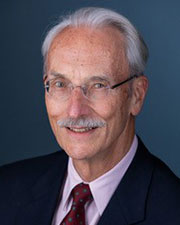 When I joined the KU Department of Medicinal Chemistry as an assistant professor in 1971, I was a well-rounded chemist with a strong background in biology but little knowledge of pharmacy per se. One of the first things I learned about pharmacy in Kansas, even before I started, was that in the late 1960s Kansas became only the second state in the union to require pharmacists to earn continuing education credits on an annual basis. Back then, that fact was a significant point of pride for pharmacy in Kansas, and in those days that CE was provided entirely by the faculty of the KU School of Pharmacy, myself included.
When I joined the KU Department of Medicinal Chemistry as an assistant professor in 1971, I was a well-rounded chemist with a strong background in biology but little knowledge of pharmacy per se. One of the first things I learned about pharmacy in Kansas, even before I started, was that in the late 1960s Kansas became only the second state in the union to require pharmacists to earn continuing education credits on an annual basis. Back then, that fact was a significant point of pride for pharmacy in Kansas, and in those days that CE was provided entirely by the faculty of the KU School of Pharmacy, myself included.
Of course, pharmacy has changed since then, but the way that CE worked in those days was that several faculty members would conjure up and prepare short write-ups on topics that might benefit practicing pharmacists. Then, on four or five Saturdays in January and February, we would pile into a van and drive out to Colby, Hays, Salina, Wichita, or similar locations and have a big dinner with 20-30 pharmacists from all around. On Sunday afternoon, we'd put on our CE program and then pile back in the van and head for home (and teaching on Monday morning). Over a decade of doing this, I met some really great Kansas pharmacists, and learned a lot about pharmacy and life in rural Kansas. Eventually, other options for Pharmacy CE came along and I became much more involved with teaching, research and writing grant applications - the bane of research-active faculty.
When I arrived at KU, research began literally on day one. I was assigned a new graduate student and shown an empty lab in the new McCollum Laboratory on West Campus. Graduate student stipends then were around $2,600 per year, but not to worry - I was given a "startup package" of $6,000 with which to equip my new lab and buy supplies until I could get some grants. University research labs were much simpler then, but as a graduate student I had been spoiled by having access to a world-class mass spectrometry facilit, and once I got here, I wanted that for KU. After a couple unsuccessful attempts to secure funding, I finally got a large NIH Shared Instrumentation Grant to buy a GC/MS instrument, and the provost funded a position for a staff person to operate it. Thus was born, in 1979, the KU Mass Spectrometry Core Lab. The MSL is still operating today with multiple instruments and three full-time staff.
I eased into teaching more gradually by sitting in on the fall semester of OMA (Organic Medicinal Agents) to get a feel for pharmacy students, to whom I would soon be teaching about steroids, hormones and other topics. During my teaching career at KU, I taught all or parts of a number of pharmacy courses, including OMA, chemistry of drug analysis, medicinal biochemistry and chemistry of disease states. The latter was a course I put together with my senior colleague and mentor Matt Mertes, in which we covered topics like cancer, viral diseases, inflammation and immunological disorders with a view to their underlying biochemistry and the potential new drugs that could be anticipated to emerge (many of which are now part of today's pharmacopoeias!). The course became quite popular and a visiting accreditation team decided it should be made a required subject. At the graduate level, I also taught bio-inorganic chemistry, drug metabolism and drug design.
I always enjoyed teaching pharmacy students, but in 2002, after 31 years at KU, my role at KU changed. I applied for and received a big NIH grant to support a Center of Biomedical Research Excellence in Protein Structure and Function. My co-investigator was Mary Lou Michaelis from Pharmacology and Toxicology (who had also been a coinvestigator on an NIH Training Grant that I directed from 1995-2001) and we were very capably assisted by Cynthia Beall. The COBRE grant paid a large portion of my salary as PI. With the salary release generated and a supplement provided by Dean Fincham and Provost Shulenberg, Med Chem was able to hire a new faculty member to take over my undergraduate teaching, so the Med Chem faculty grew by one, and I continued teaching graduate courses, doing research and running the COBRE Center. COBRE-PSF helped us build three more KU Core Labs and supported almost 70 faculty members in various departments at KU, KSU, KUMC and WSU with research support, mentoring and most of all collegiality and community. The COBRE program ran from late 2002 through May 2020 when the grants all ended and I retired as planned.
When I joined KU, the Med Chem department had only five faculty members, so I made it six. Over the next several decades, the department grew to a total of 13 full-time, well-funded faculty and developed a very strong reputation at home and abroad. By 2010, though, our excellent reputation became a liability as other universities started recruiting Med Chem faculty away from KU. Over the past decade, eight of our senior faculty were recruited away, while two others retired. In 2017, while planning my own impending retirement, I was drafted to step in as interim chair and stabilize the department. Fortunately, during the last four academic years, we were able to recruit one new senior and five new junior faculty, so with my retirement in May 2020, the department had a good complement of three senior and five junior faculty, and spirits were high once again. With the opening of the new Interdisciplinary Science Building (aka Gray-Little Hall) in August 2019, the Med Chem Department moved out of Malott Hall entirely and is now quartered in just two buildings, the ISB and the Shankel Structural Biology Center on west campus.
As I look back, I realize that no one ever completes a successful career totally on their own. I certainly had help at various times from some outstanding colleagues at KU, including Ed Smissman, Matt Mertes, Bob Wiley, George Traiger and Dick Schowen. I also had the good fortune to work with 52 graduate students and postdocs, many of whom I still keep in touch with. We had been planning a big KU reunion and retirement symposium for April 2020 but while Covid-19 nixed that gathering, it didn't stop the production of a Special Issue of Medicinal Chemistry Research (29:7, July 2020, edited by Longqin Hu, Binghe Wang and Siming (Liu) Wang), in which 15 former associates honored me by contributing articles. While at KU I also had a chance to develop a rapport with many scientists from Pharma whom I met through annual summer Gordon Research Conferences, and with whom I was able to help establish the International Society for the Study of Xenobiotics. I am pleased that next year ISSX will celebrate its 40th anniversary as the premier international society for drug metabolism scientists.
Overall, I consider myself very fortunate to have landed at KU and to have had such a rich and rewarding career. In gratitude, Lois and I have established the Bob and Lois Hanzlik Fund for Medicinal Chemistry at the KU Endowment Association as a match to funds that Med Chem alumni contributed to the "Mission Impossible" campaign of 2019. Collectively, these funds will support the department by supporting graduate students and the graduate program in Medicinal Chemistry for years to come. Lois and I wish the department and the school all the best for the future.
Thank you for your interest in supporting the Department of Medicinal Chemistry
Privately given support from our friends and alumni allows the Department to enrich its programs in ways that are not possible with limited state support or research grants restricted to specific purposes. Privately given unrestricted support is what allows us to continue the excellence you have come to expect from our department. Your support, regardless of amount, can make a profound impact.
To make a donation, visit the KU MedChem: Giving or contact our development director, Beth Bucklin, at bbucklin@kuendowment.org or 785-864-7477.
Medicinal Chemistry | University of Kansas School of Pharmacy
Shankel Structural Biology Center 2034 Becker Drive, University of Kansas, 66047
medchem@ku.edu | 785-864-4495